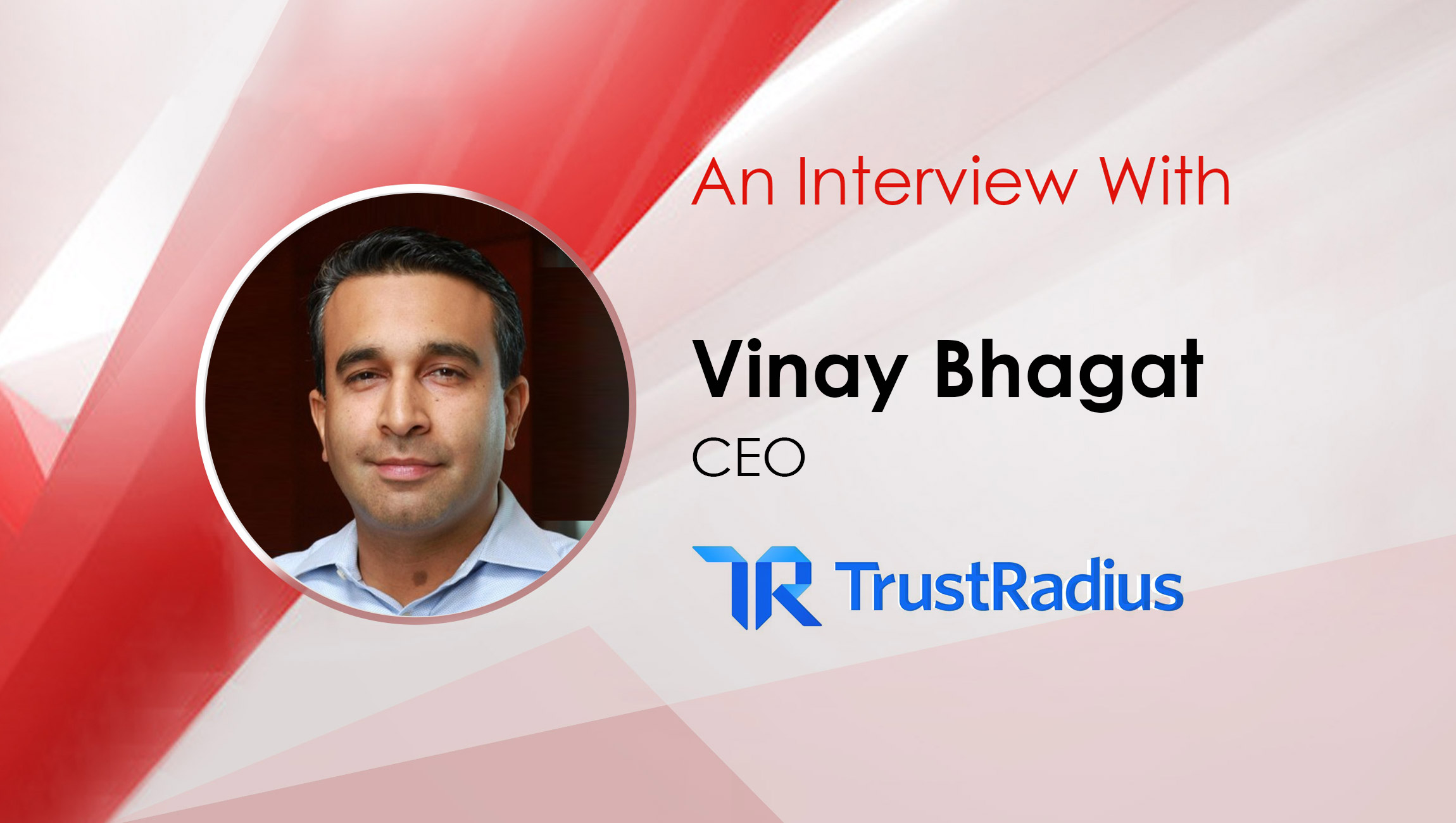Vinay Bhagat, CEO at TrustRadius emphasizes the importance of intent data in a typical B2B buying-selling environment in this quick catch-up with MarTech Series:
________
Welcome back to this 2022 MarTech series chat, Vinay, we’d love to hear about some of TrustRadius’ latest feature introductions, and especially, a little more about your latest integration with Demandbase. What inspired this and how does it help end users?
B2B technology marketers are struggling to find and win customers. 65% of business technology purchases are made by Millennials and Gen Z who have brought their consumer buying behavior to work. They want to self-educate and only engage sales once they’re ready to. This means that technology brands are in the dark about many purchasing cycles until it’s too late to have influence. In this context, leveraging buyer intent data to drive ad strategy and sales outreach has become an important strategy.
TrustRadius provides unique buyer intent data derived from interactions on our site. Because of the nature of our audience – largely arriving due to purchase related search terms and secondly the deep engagement on our site (10+ mins on product review pages, 11+ mins on comparison pages), interactions and pageviews on our site offer a very strong signal of purchase intent – much more so than typical third party intent data. We call this “downstream” buyer intent. Additionally, we enable brands to ID and engage companies that are researching competitive products in their category but not them.
Our integration with Demandbase, makes it easy for our shared customers to action this valuable “downstream” buyer intent data, to run display and social ads and to guide sales led outreach.
Prospects are met with relevant messaging making them more likely to convert, marketers are providing higher yield for their marketing dollars, and sales teams are closing more deals at an accelerated rate.
With intent data and intent signals becoming more sophisticated, what do sales and marketing teams need to do in order to stay abreast and get ahead of the competition, especially in a competitive market where the most successful teams are pursuing data-driven tactics to drive optimized sales/marketing campaigns?
Marketing and sales teams need to understand where intent signals are coming from and, based on the source, how to differentiate their engagement with those accounts.
Most intent data used today are third-party signals derived from website visits across the internet, then modeled for marketing or sales to action on. Most of these signals are based upon topic searches which are more aligned to top-of-funnel research. Marketers should use these signals to initiate nurture with thought leadership and educational content before passing them off to their sales team. Those signals should not be passed directly to their sales team for engagement. Many marketers have grown disenchanted with intent data because they don’t understand this nuance.
With TrustRadius downstream intent data, we know that prospects are closer to a purchase since they are researching your product and competitors by looking at reviews, comparisons, alternatives, pricing, etc. These signals are consequently more sales ready, but also yield good results when used to drive mid and bottom funnel campaigns, e.g. attendance at a webinar, booking a demo or initiating a trial.
When marketing to prospects who have been active on a review site, you’ll materially improve your response if you use social proof associated with the review site. This could include award badges and also quotes.
If you can identify that a prospect is looking at a specific competitor, you should be reaching out with differentiated messaging and social proof to make sure you are in their consideration. For example, run ads which say, considering brand X, here’s why you should look at Y and then lead buyers to an explanatory conversion page with quotes from reviews that enumerate your differentiation.
Marketing Technology News: MarTech Interview with Jon Miller, CMO at Demandbase
With sales and marketing teams having better access to richer data sets, there’s a deeper need for operations on both teams to pick up the pace and collate practices to drive and feed campaigns and customer-facing executives. What best practices can you share?
First it’s important to parse whether the signals are for current customers or prospects. Intent data associated with a current customer could indicate they are a churn risk, or could indicate an expansion opportunity. Based upon the product set they are researching, the likely scenario should be quite obvious. Operationally it is important to route this data to customer success and account management teams, potentially into a system like Gainsight.
For prospective customers, it’s super important to make sure the data is put into systems where it can be actioned. With TrustRadius “downstream” intent, we recommend feeding the data into Salesforce so that BDRs and sales people both can engage new prospects but also have intelligence on active deals they’re working. We also recommend feeding the data directly into LinkedIn for advertising and to ABM systems like Demandbase.
Having a solid data foundation to understand your customers and prospects is table stakes at this point. When you think about the rise of account-based marketing, it was built on the notion that sales and marketing are aligned on target accounts and are moving in the same direction to break into them. This is evolving to be more sophisticated with platforms like Demandbase because sales and marketing teams can gain more access to data through integration, then model that data and prioritize which accounts to target and how. Use the data and intelligence you have to segment and message properly across sales and marketing to be successful, now and in the future.
What are some of the top trends that come to mind for 2022 and beyond when it comes to evaluating the B2B marketing and MarTech space?
Buyer self service – 65% of today’s B2B tech buyers are millennials and Gen Z. They have brought their consumer buying behavior to work. They seek advice from peers from from independent forums like communities, review platforms. They expect to see pricing (at least at a high level). They want to understand if a product is right for their specific use case.
Customer advocacy / voice – in a world where buyers trust customers more than you or analysts, it’s essential to activate your customers to speak for you – through written content, videos, and in forums. The side benefit of collecting public customer testimony is great feedback and insights to drive product product development and positioning.
Marketing Technology News: TrustRadius Announces LinkedIn Matched Audiences Integration
As MarTech and B2B marketing evolves, what does a typical B2B marketing team need in order to work well together? What kind of team members, roles, and skills are needed to comprise a ‘’healthy’’ marketing team in your view?
Marketing teams will need to become more integrated instead of siloed, as they are now. Since the buyer’s journey is not linear, your team has to build around the entire customer journey, from acquisition to renewal. The more integrated the approach from messaging, content, and channel distribution the better. You have to be consistent with your messaging wherever your brand is present. Your narrative and brand will be what separates you from your competitors and what will build brand loyalty with your customers.
The other piece is data and operations. You have to invest in your data architecture, hygiene, storage, and activation, otherwise, you can’t have an integrated approach. Healthy teams need strong best practices when it comes to data to allow for agile and cohesive marketing.
Some last thoughts and takeaways before we wrap up!
Buyer behavior has changed and winning companies will need to adapt to new preferences when it comes to buying software. Technology providers will need to be discoverable, allow buyers to self-educate, and reach out with the right message at the right time. The marketing teams that have a strong data foundation, use the customer voice, and have an integrated approach will be the most effective and successful.
TrustRadius is a trusted review site for business technology, serving both buyers and vendors. The platform helps buyers make better product decisions based on unbiased and insightful reviews.
Vinay Bhagat, founder and CEO of TrustRadius, is an entrepreneur passionate about improving the software buying process so professionals like HR teams can make better decisions for their organizations. Vinay started TrustRadius after experiencing challenges when buying enterprise solutions. In 1999, Vinay founded Convio, the leading SaaS platform for nonprofits. In 2010, Convio went public and was acquired in 2012 for $325 million. Prior to Convio, Vinay was at Trilogy Software and Bain & Company. He holds an MBA from Harvard Business School, an MS Engineering Economic Systems from Stanford University, and a MA Engineering Information Sciences from Cambridge University.
Missed The Latest Episode of The SalesStar Podcast? Have a quick listen here!
Episode 121: Sales Enablement Trends for 2022: with Carson Conant, Founder and CEO at MediaFly
Episode 120: The Future of Customer Success with Guy Nirpaz, Founder and CEO at Totango
Episode 119: Sales Trends that Generate Better ROI: with Scott Smyth, VP Global Sales at HG Insights




